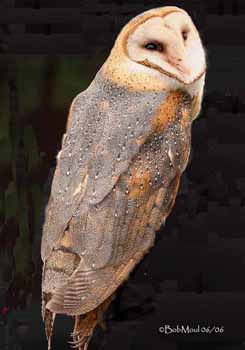
STRIGIFORME ORDER
TYTONIDAE FAMILY
The Order Strigiformes gathers two owl families, the Tytonidae (Barn-Owls and Bay-Owls), and the Strigidae or typical owls.
We start with the Tytonidae which gather 14 Tyto Owls species and 2 Bay-owls.

The Tytonidae usually have a rounded head with a heart-shaped facial disk. Tail is squared and the legs are fairly long. The strong feet are armed with powerful talons.
They often have dark upperparts with markings, and pale underparts. We can find pale and dark morphs, according to the geographical range, and numerous variations are known. Markings are usually fine, forming loose vermiculations or barring.
Tytonidae have cryptic plumage which provides them an excellent camouflage. Females are larger than males. The juveniles are usually darker than adults until they reach their sexual maturity.
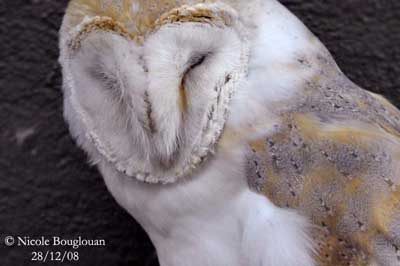
These birds are very well adapted to their nocturnal behaviour, thanks to the shape and feathers’ composition of the facial disk, the asymmetrical ears and their keen eyesight due to the large eyes.
The Tytonidae may be found from sea-level up to 4000 metres of elevation in the Andes and New Guinea.
According to the species, these owls frequent rainforest, forest-edges, wooded farmland, swamps, mangrove edges, lowlands with scattered trees. Their habitat must be suitable for hunting and nesting.
Tytonidae are almost all nocturnal birds, living alone or in pairs. They often are sedentary and occupy their territory all year round and over several years.
They utter various screeches and screams, but also some whistling sounds. During the breeding season, they give a cacophony of numerous sounds uttered by both sexes and young.
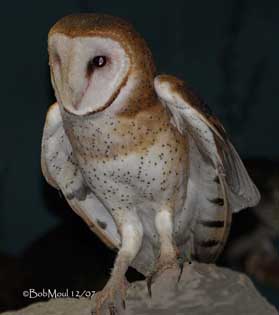
Tytonidae hunt small to medium-sized mammals and also birds, reptiles, amphibians and insects, according to the range and the season. But they hunt mainly small mammals such as rodents, mice and voles.
The prey is usually swallowed whole, but owls regurgitate pellets later, made with bones, fur or feathers.
They fly silently close to the ground, searching for preys, and dive on to prey when detected and localised, with extended talons ready to catch it. They also hunt from perches.
These owls nest in natural cavities, often in trees, but some species nest on the ground, in abandoned burrows, among the clutches of grass.
Several weeks before laying, males call frequently at potential nest-sites at night to attract females. Males perform display flights while calling, making short flights over the area. They also may offer food to the female during the courtship displays.
The clutch size varies according to the food resources, from 1-2 eggs to 4-7 and more in the Common Barn-Owl.
The incubation is done by female which develops a brood patch. The period may last about one month, but varies with the species from 29 to 42 days. The male hunts and feeds both female and the young. Fledging period also varies with the species from 42 days to 60, 84 or 90 days.
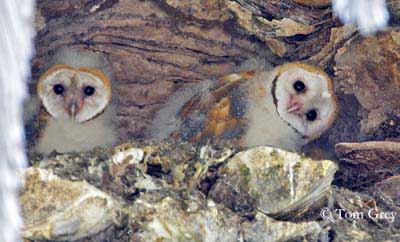
The Bay-Owls are smaller in size than Tyto forms. They have more triangular facial disk, divided at forehead level. They usually have dark brownish plumage, heavily marked on the upperparts, and paler on underparts.
They frequent mainly forests because they are smaller, but their behaviour is probably similar to that of Tyto forms, although little known.
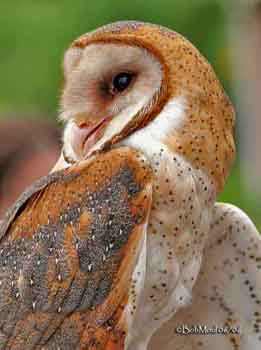
Owls are fascinating birds, and since ancient times, they may be feared, venerated, considered lucky or not. They often are associated with various superstitions and are sometimes killed by humans.
Owls die for starvation, collisions with wires or vehicles. They are preyed upon by larger owls or other animals such as mammals or snakes. The degradation of the habitat and the use of pesticides reduced the numbers of rodents and the foraging habitats.
Conservation programs are in progress or active, in order to protect these birds and their habitat.
Text and portrait by Nicole Bouglouan
Photographs of the adults by Bob Moul
His website:
Nature Photography
Photographs of the young at nest by Tom Grey
His website:
Tom Grey's Bird Pictures
Sources :
HANDBOOK OF THE BIRDS OF THE WORLD Vol 5 by Josep del Hoyo-Andrew Elliott-Jordi Sargatal - Lynx Edicions - ISBN: 8487334253
Animal Diversity Web (University of Michigan Museum of Zoology)